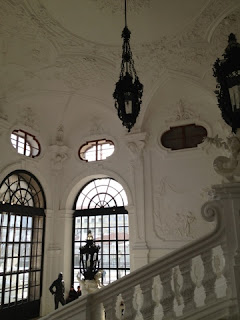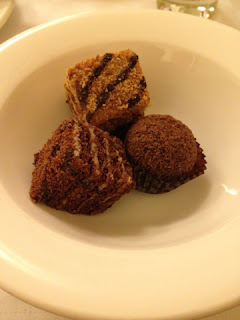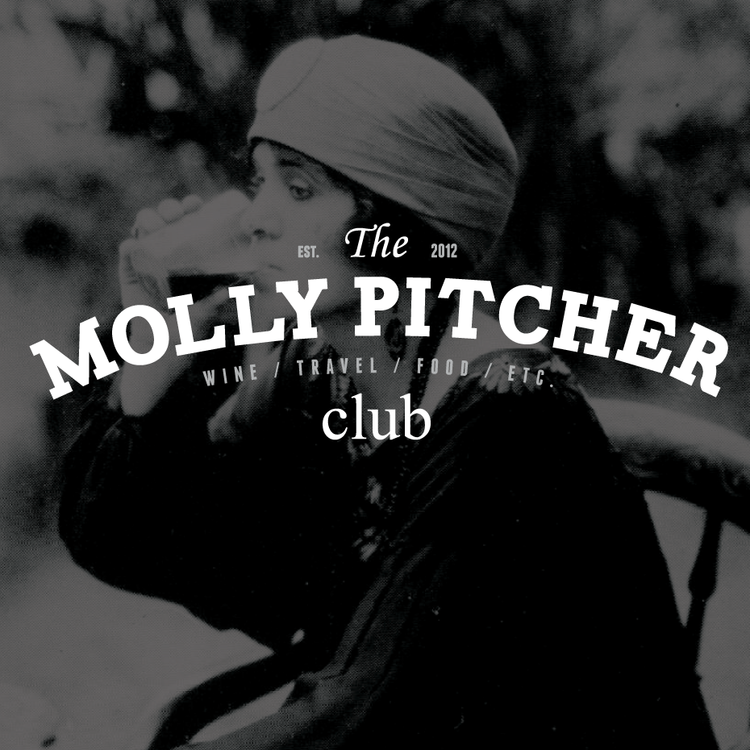Vienna: das Ende für Österreich
Last post from Vienna!
All good things must come to an end, and with a heavy heart, the group said good-bye to Vienna. We will not miss the snow, cold, and more snow - but - we will miss the sites, food, drinks and friends. Today's topics: a sneak peek at the inside of the Belvedere Palace, Weissburgunder, and the weird and wonderful Austrian breakfast - featuring melange.
Last post, I introduced the Belvedere Palace and Prince Eugene's desire for a bigger and brighter palace that would easily have made it on
. (Full Disclosure - at first I could not even remember the full name of this show, so I had to google - the wikipedia description is somewhat humorous and provided for those can't remember either). What you did not get to see were some images from the inside! There are two reasons for this: (1) I had to take these pictures secret-agent style because we were not allowed to take pictures, even without flash, and, (2) The main rooms were so beautiful - they deserved their own separate post.
Featured below is the grand staircase (left) and the main ballroom (right). Now, I have seen a few castles in my day... Versailles (twice), The Louvre, Neuschwanstein... just to name a few. But this summer residence of Eugene's still managed to show me something awesome and different - uniquely vaulted ceilings. If you look at the windows in the main ballroom, those were on the third floor and allowed visitors to look both down into the ballroom and out to the view of Vienna. Definitely a sight worth seeing.


Next, a topic for my most dedicated readers (and newbies who love fermented grapes) - wine! More specifically, what is weissburgunder? On our last day in Vienna, we stopped at a local wine store. Of course, I went straight to the
and grabbed a bottle. On my way there, I saw a bottle of weissburgunder, and thought: I have no idea which grape this is exactly, but it looks interesting, so why?! I had never seen this name on the label before and initially thought maybe it was a translation for white burgundy. But, I definitely had my doubts because I found it highly unlikely that anything French
and
wine-related would be in any other language besides French. With some research, I learned that weissburgunder is actually how the Germans/Austrians refer to
pinot blanc.
Pinot blanc is a white grape and produced in several countries (in order of estimated quantity): Alsace (France), Italy, Germany, Austria, Hungary and others. Generally, pinot blanc has a medium-dry to dry taste and oak is not typically used during maturation. Its flavor profile includes: citrus, melon, pear, apricot and perhaps smoky/mineral undertones combined with high acidity.
Other synonyms for pinot blanc include:
pinot bianco (
Italy
), pinot branco, rulandsky bile (or Rulandské Bilé in the
Czech Republic
), Rulandské Biele (
Slovakia
), and
Feher burgundi (
Hungary
).

For my third and final topic, Austrian breakfast. To some Americans (and other non-natives) breakfast in Austria may seem weird. Well, maybe not weird, but more like - lunch? It's true, if you have not been to Germany or Austria before, the breakfast spread includes: rolls, meat, cheese, yogurt, vegetables and other similar items Americans would rather see around noon. Personally, I think it is the best breakfast around and would back the movement to serve this style breakfast in the US tomorrow. There is one caveat though, today I saw a new breakfast item that was somewhat strange (and may not need to jump the pond) - tiny chocolate cakes/truffles. I grabbed a few (merely for experimental purposes), despite my sentiment that chocolate truffles are a bit too decadent for breakfast, and they were surprisingly good! The taste was no where near as sweet as a similar item in the states would be. So definitely worth a try for the adventurous breakfast lover.
Speaking of breakfast, this brings me to my last topic, melange. If you visit one of Vienna's many cafes, you will definitely see melange on the menu. I have ordered this traditional Viennese coffee drink on several occasions during my trip and it is always great. But, it also tastes similar to a cappuccino and I wondered what was the difference. From what I read (and if any of my European readers want to correct me - feel free!) classic melange differs from cappucino because the strength of the coffee brew is less pronounced and it may be served with whipped cream instead of frothed milk. All differences aside, melange is delicious and I will definitely miss it.
Other places to see in Vienna:
Zum Schwarzen Kameel (high end food store/restaurant), Figlmuller (traditional schnitzel - the size of a plate), MuseumsQuartier, and basically any bakery.
And with that - stay tuned for new posts on my adventures in Spain!
Cheers!
